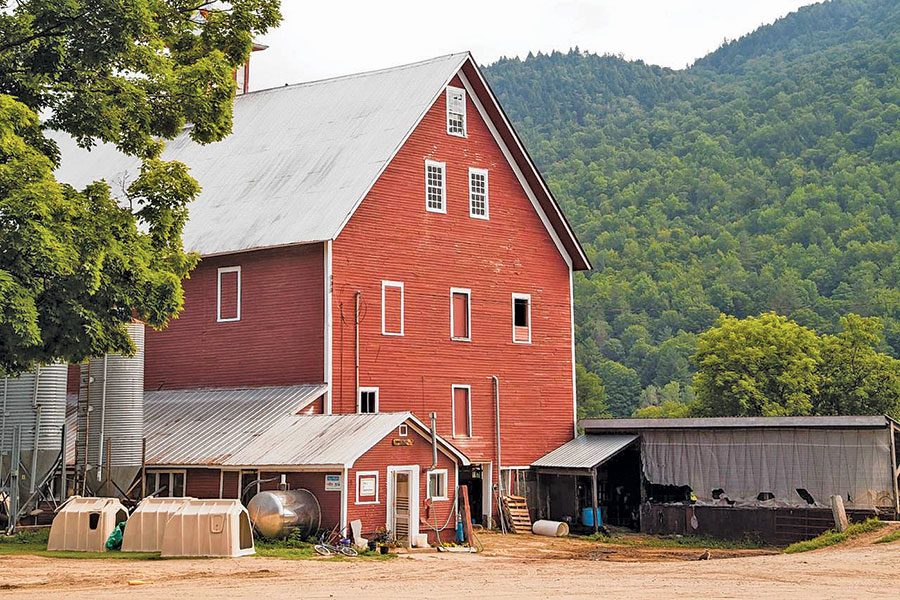Declining milk prices put the squeeze on Vermont dairy farms
Liberty Hill Dairy Farm
Dairy farming has been a pillar of Vermont’s economy and culture for centuries. The industry is so deeply ingrained in the state’s identity that its flag features a Jersey cow standing in a pasture in front of the Green Mountains. For farmers, it’s more than a job, it is a lifestyle, one which is frequently passed down through families generationally. But as milk prices continue to plummet, more and more farmers are facing the harsh reality that their businesses may no longer be financially viable.
During the early 1800’s, Vermont was known for growing grains until competition from the Midwest forced the farms to transition to sheep. Wool was king in the state until prices collapsed, and farms changed once again, this time to dairy. By the early 1900’s dairy farming was entrenched as a way of life for Vermonters. In 1927, the state was home to 27,000 farms and approximately thirty percent of its citizens were involved in milk production.
The Great Depression predictably caused significant erosion within the dairy market and directly lead to the passing of the federal Agricultural Adjustment Act in 1937, which gave the government control over pricing. Following World War II, a parity pricing system was introduced and supported by farmers across the country. Essentially, the parity system provided pricing equitable to the prices that existed from 1910-1914 and led to one of the most lucrative agricultural eras.
Over the next few decades, the government passed minor revisions to the Agricultural Adjustment Act, but the parity system remained intact. However, it was eventually phased out of milk pricing in favor of a free market system in the early 1980’s after the passing of the 1980 Farm Bill and the Agricultural Food Act of 1981. This shift signified the end of cost of production being a factor in pricing and ushered in the era of market volatility that still remains today.
Milk prices reached a pinnacle Sept. 2015 at $24.50 per hundredweight (100 pounds of raw milk, approximately 11 gallons). Now, a hundredweight of milk sells for only $15.40, a decrease of nearly 40 percent and the eighth consecutive year of decline. In 2014, the 2.67 billion pounds of milk produced in Vermont fetched $626 million, while the 2.73 billion pounds produced in 2017 made just $454 million.
In an attempt to safeguard themselves against such steep price drops, 67 percent of Vermont dairy farms enrolled in a price protection program created by the 2014 Farm Bill. This program ensures participating farmers financial assistance if and when the difference between price of milk and national average feed costs drops below the coverage margin chosen by each individual business.
Often, when farmers see the milk prices begin to dip, they prepare by prepaying for the necessities of operation, which can also provide tax benefits. These necessities include grain, fertilizer, seed and sometimes new equipment. But even planning ahead like this doesn’t stop them from losing money when prices sink below operating costs, as it is merely a temporary solution.
Even these precautions have not prevented the closures of farms throughout the state at a rapid pace. In 2010, Vermont was home to 1,015 dairy farms. As of this past March, that number has plummeted over 26 percent to 750, with many more currently weighing the decision to sell or not. When compared to the dairy farming landscape back in 1975, the plunge is even more precipitous, as nearly 4,000 farms existed in the state at that time.
According to the Vermont Agency of Agriculture, most of the farms that have closed had fewer than 200 cows. Simultaneously, the amount of farms with over 700 cows has increased twofold in the past five years, showing a statewide trend of consolidation.
The Vermont Dairy Promotion Council, in partnership with the Vermont Agency of Commerce and Community Development and the Vermont Agency of Agriculture recently concluded a study, which began in 2014, to measure the full impact of the industry on the state’s economy and way of life. They found that dairy brings $2.2 billion in economic activity to Vermont every year, as well as $3 million in circulating cash daily. In addition, the sale of dairy and dairy byproducts brings in $1.3 billion in annual sales, which accounts for more than 70 percent of the state’s agricultural sales, and 63 percent of the milk produced in New England comes from Vermont. Lastly, the dairy industry provides nearly 7,000 jobs, and each individual dairy cow creates $12,500 in annual economic activity.
The study also provided data on the significance dairy farming currently has on the Vermont landscape. Dairy farms and the fields used to grow their feed cover 15 percent of the state and account for more than 80 percent of its farmland. However, this land is not used just for farming, as 66 percent of Vermonters reported using farm land for recreational purposes.
The Vermont Dairy Promotion Council also polled Vermonters to gauge the importance of the industry on their lifestyles and the results were remarkably high. 97 percent of those polled said dairy farms are important to the state, while 92 percent agreed that they add to Vermont’s beauty. Additionally, 91 percent said dairy is important to Vermont’s way of life.
So why are milk prices so low? The simple answer is excess milk. There’s significantly more supply than demand, even with the decrease in dairy farms throughout the state. Back in 1975, when the state’s dairy cow population was 189,000 on 4,000 farms, they produced around 2 billion pounds of milk. In 2012, the number of farms hovered around 1,000 with 132,000 cows and produced 2.6 billion pounds of milk. That’s a 75 percent decreased in farms, a 30 percent decrease in cows, but also a 30 percent increase in milk production.
The growth in supply is attributed to advances in farming and technology like better breeding and nutrition. In 1950, an average Vermont cow was responsible for 5,400 pounds of milk per year. That number increased to 12,000 pounds in 1980 and now approaches 20,000 pounds.
“This is one of the most difficult periods our farmers have faced. It’s frustrating because our hard-working farmers are trapped in a federal pricing system that’s outdated and crippling our farmers,” the Vermont Agency of Agriculture said in a statement.
Another contributor to the financial struggles of the dairy farmer has been government regulation. Within the past few years, mandates have been passed by the Environmental Protection Agency to reduce the phosphorus pollution of lakes and streams caused by farm runoff. The mandates control how manure is stored and how close cows can be to bodies of water, among other things. In order to be up to code, farmers are spending thousands of their own dollars on water quality improvements.
When farms suffer, so do the companies they do business with. Grain suppliers, tractor salespeople and local restaurants across the state have been impacted by the ripple effect of the dairy industry’s struggles. Middlebury-based Champlain Valley Equipment has experienced a 10 percent dip in sales since 2014, forcing owner Brian Carpenter to reduce his staff by a corresponding 10 percent in 2016.
To avoid selling their farms in full, many Vermont dairy farmers are slowly auctioning off portions of their herds in hopes of staying open a few more years, perhaps until milk prices rebound. Meanwhile, others are plunging further and further into debt, or pooling resources with other local small-scale farms. The most common responses are increasing milk production even more, which only serves to continue to drive down prices, and transitioning into a different form of agriculture.
But these methods can only fend off the inevitable for so long. The ultimate solution to milk price volatility must come from Congress. “If the problem of oversupply isn’t fixed, a dark cloud hangs over the future of dairy in Vermont and across the nation,” said Vermont Rep. Peter Welch to the Burlington Free Press. “All of us who represent rural America are seeing the impossible burden we’re putting on dairy farmers. They can be the most efficient, hardest working, most innovative farmers anywhere, but if the price is less than the cost of production, they’re not going to be able to milk the cows.”
President Trump’s affinity for trade wars have placed even more strain on the dairy market nationwide. The stagnation of domestic demand over the last 10 years has caused exports to now make up 15 percent of the American dairy market. Trump has created strife with the U.S.’s top three customers—Mexico, Canada and China. As he continues to provoke a trade war with China and disrupt the North American Free Trade Agreement, the industry will remain unpredictable.
Ultimately, the answer could be adopting a milk pricing system similar to Canada’s, which utilizes production quotas. Thus far, federal attempts to make this change have been strongly opposed by dairy manufacturers. But Canada’s milk prices have remained undeniably high and stable under the quota system. Reforms to the next Farm Bill will be made later this year, although it’s doubtful they occur before the fall midterm elections.






